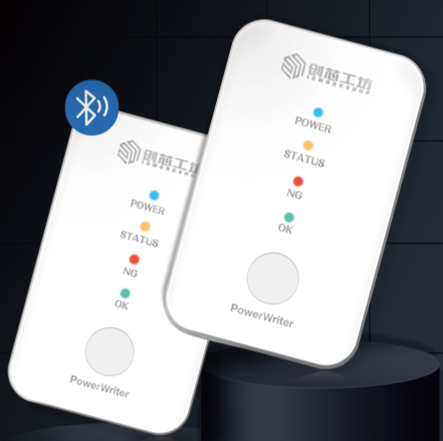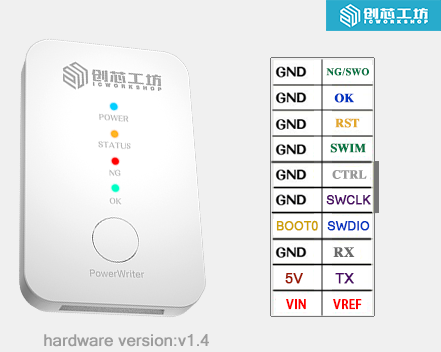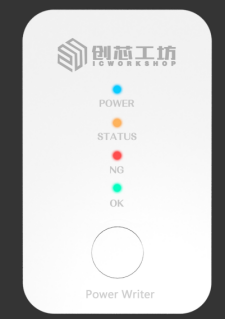2.1 Characteristic
The interface definition parameters described in this section apply to PW200 ,PW300 devices, and the Characteristic apply to all PowerWriter® devices.
- For PWX1 devices, please refer to PWX1 Functional Parameters.
- For PWLINK2 (Lite) devices, please refer to PWLINK2 Function Parameters.
- For PW400 devices, please refer to PW400 Functional Parameters.
- For ICWKEY device, please refer to ICWKEY Functional Parameters.
The status descriptions of the different products can be found in PowerWriter® device operating status description.
2.1.1 Summary
PW200/PW300 is the ICWorkshop universal debugger, online programmer, offline programmer one integrated development tools, mainly facing the individual developers and small batch production, authorization control field, rich features, safe design, can meet the developers from the development of the debugging, on-line verification, to the product of the whole process of mass production needs.
There are slight differences in functionality between product models, the full-featured device is the PWX1 (abbreviated as X1), see the PWX1 User's Manual.
2.1.2 Parameter

- Product Size:92.000mm 56.000mm 16.000mm
- Power supply:DC5V
- Consumption:30mA@5V~100mA@5V
- Driving ability:5V@700mA (Max)
2.1.3 Packing List

2.1.4 Interface
2.1.4.1 Output
The PW200 (PW300) interface is a mix of burner station signals, TRACE signals, SWIM signals, standard serial signals, BOOT0 control, and power supply (the power supply supports outputs of 1.8V, 3.3V, and 5.0V, and can also be used as an input reference to the PowerWriter® logic levels) as shown in the figure below:

| Name | Descriptions |
|---|---|
| VREF | Target chip IO reference voltage output(VDDIO) |
| VIN | Alternative power supply for devices (support voltage range2.8V~5.5V) |
| 5V | Device 5V output (commonly used to drive motherboards) |
| GND | Power Grounding |
| TX | Universal serial port, ISP burn-in, unlocked transmitter (device side) |
| RX | Universal serial port, ISP burn-in, unlocked receiver (device side) |
| SWDIO | Data line for SWD interface SWDIO |
| SWCLK | SWD interface clock line SWCLK |
| BOOT0 | Target chip BOOT control pin |
| SWIM | SWIM interface cable |
| RST | Target chip auxiliary reset control pin |
| CTRL | Control burn-in (low pulse start) |
| OK | Successful burn status output (output high) |
VREF (VEXT) voltage is the target chip IO reference voltage. The output voltage can be set to 1.8V, 3.3V, 5V through the configuration software, or it can be configured as an external input reference voltage to switch the logic level of the PowerWriter® with reference to the operating voltage of the external chip.
Different versions of hardware, different models of hardware, there are slight differences in the interface, please refer to the actual prevail, the new version is compatible with the design of the old version and provide more features.
The Power Writer supports drawing power from the USB connector and powering the device from the burn port VIN:
| Power supply method | Input Voltage | Descriptions |
|---|---|---|
| USB | DC 5V | Make sure that the input drive capacity is sufficient |
| VIN | DC 2.8 -5.5V | Below or above range may not work |
2.1.4.2 Front

2.1.4.2.1 Indicator
- POWER : Power indicator (blue).
- STATUS: Status indicator (yellow).
- NG: Programming failure indicator (red).
- OK Programming ok indicator (green).
2.1.4.3 Button
When the key is pressed , offline programming is initiated.
When programming offline, please close the PowerWriter® application or operate it after disconnecting the device.
2.1.4.4 State
| Signal Name | Signal Description |
|---|---|
| POWER LED | Always on at power-up |
| STATUS LED | Does not light up during power-on without operation |
| Blinks when communicating with the application software, and the blinking frequency follows the communication speed setting. | |
| Blinking during offline burning, blinking frequency follows communication speed setting | |
| When connected to the target chip, it will always light up | |
| NG LED | Lights up when there is an operation error and the read, erase, or programming operation fails, and goes out until a new operation is performed. |
| OK LED | Lights up when an operation such as read, erase, or program is successful and goes out until a new operation arrives |
| Buzzer Frequency Definition | The PWM frequency is 2.7K Hz (defined below). |
| Buzzer count definition | A beep when the target chip is connected |
| A beep when the target chip is connected | |
| Two beeps when the burn is successful or the download of the offline file is successful | |
| Three beeps when the operation fails | |
| Four beeps when the number of offline count is 0 | |
| Button | Effective when doing offline burning (release trigger, longer than 1S ignore long press) |
| OK signal pin | Outputs high when an offline operation is successful and clears 0 when a new operation is performed. |
| NG signal pin | Outputs high when an offline operation fails and clears 0 when a new operation is performed |
| CTRL signal pin | Input a low signal >= 40ms to initiate a single offline burn-in (Press and release.) |
2.1.4.5 Functional
Supports data encryption.
Support for importing and exporting projects.
Supports loading encrypted projects into PowerWriter® for offline mass production control.
Support reading offline projects from PowerWriter®. (Note: correct password is required).
Supports online chip Program Flash area reading.
Support online chip Program Flash area read address, read size setting, whole chip read function, convenient to read the firmware data of the target chip.
Support online chip check empty.
Support online erase chip, developers, users can directly erase the target chip through the software.
Supports on-line burning of data in the Program Flash area, allowing users to write firmware speeds through on-line programming, rather than having to write off-line, or through Debugger methods such as MDK/IAR/CUBEIDE.
Supports online verification of Program Flash data.
Supports on-line auto-programming to automatically perform Erase, Write, Verify, and Update Option Byte functions.
Supports online reset of the target chip.
Supports setting read protection: Level-0,Level-1,Level-2 levels can be set, and automatically recognizes whether the user's protection bit is on or not.
A full list of Option Byte settings is supported.
Supports full Option Byte default settings.
Option Byte supports multiple languages.
Supports automatic recognition of the options in the Option Byte and execution of the corresponding operations.
Support online factory restore Option Byte
Supports online reading of Option Byte
Support for reading option bytes of locked chips
Supports online writing of Option Byte
Supports saving user-defined option bytes, users can save the set option bytes to a file, which can be sent to the burner or used for other purposes.
Support for loading user-defined option bytes, which can be loaded into a project from a saved option byte
Option Byte dynamic real-time synchronization, connected to the target chip automatically synchronized to the PC client
Support Bank auto recognition
Supports multiple Option Byte update methods
No operation before burning -> No operation after burning
No operation before burning -> Write user-defined Option Byte after burning
Option Byte to restore factory settings before burning -> no operation after burning
Restore factory settings to Option Byte before burning -> Write user-defined Option Byte after burning
Supports online reading of target chip Chip ID, which is convenient for users to check Chip ID, and for non-contiguous Chip ID, it is automatically given in the form of continuous address.
Support online arbitrary address to read the internal data of the target chip, mainly used for developers Debug to analyze the target chip, and can be arbitrarily set to read the address and read the size of the read, see the relevant sections for details, mainly used for:
Read any memory data
Read any Flash data
Read any register data, etc.
Support automatic online upgrade of software (with network)
Multi-language support, complete support for the ARM Cortex-M chip support
Supports multiple erase methods: Page erase, full-slice erase, Bank auto-recognition erase (no user selection required).
Supports multiple voltage options, 1.8V/3.3V/5.0V/ or user-defined reference voltage
Support programmed speed free adjustment, 5Khz~20MHZ speed free adjustment.
Support buzzer on-line alert tone, please refer to signal definition description section for definition rules.
Supports serial number writing, can set serial number address, initial value, step size, size end mode
Supports switching between decimal and hexadecimal display of serial numbers
Supports serial number address, legality check (automatically checks for overlap with other setup addresses)
Supports offline burn count settings up to 4.2 billion times
Supports automatic chip detection and automatic start/stop burning when chips are put in.
Supports setting the stabilization time for automatic chip detection, default 100ms
Support to set the delay time for taking away the chip when burning chip automatically, default 100ms.
Supports switching between decimal and hexadecimal display of burn count setting information.
Supports legitimacy checking of burn count setting parameters
Supports startup of the target chip after burn-in (Reset & Run).
It supports to turn off the power output after burning the target chip, which can effectively protect the chip from being charged and removed from the burn-in base by turning off the power output after burning when batch burning.
Supports setting of power supply stabilization time or power-down stabilization time before and after burn-in (valid with power output off option on)
Supports setting the RESET pin signal control, and supports the following three modes
Output Normally Low
Off output (high resistance state)
Output off after reset (reset signal generated before burning)
Support data verification: verify whether the data burned to the target chip is correct or not, enabled by default
Support UID Chip Authorization Burn-in on-line Chip Authorization Server
Supports Power Writer's built-in offline authorization algorithm for chip authorization
Supports flexible settings of key storage address, key size (4/8/12byte), key size end mode, and user-defined password for Power Writer's built-in offline authorization algorithm.
Supports user-defined offline authorization algorithm functionality instead of several existing models
Support for automatic generation of random offline authorization algorithms, Power Writer can automatically generate random offline authorization algorithms, each of which is unique and the possibility of duplication is almost zero Automatic generation of random offline authorization algorithms, support for algorithmic strength checking, and provide manual adjustments to the reference suggestions. Users can manually adjust or re-generate until satisfied!
Support for the definition of offline authorization algorithms export Sample Project, users only need to export the source code compiled into the project to achieve offline authorization algorithms, convenient and fast through the perfect system kernel scheduling mechanism, Power Writer can perform concurrent operations at the same time.
Support complete online operation log display, timely alert users, the log mainly contains the following colors.
Light blue: represents general operational results
Green: indicates successful operation
Red: represents an error, or some other critical information, such as Power Writer disconnected links
Yellow: indicates a warning that there may be a problem with the operation, or a hint that there may be a problem with the settings
Support log reset, save log, want to save the operation record, try to save the log to backup, so that in the future when encountering problems can clearly see the last operation process.
Supports encrypted saving, loading of burned configuration parameters.
Supports full chip Flash space mapping with HEX view, allowing users to visualize the loaded raw data.
Supports copy and paste operation of Flash data area, users can edit Flash data area.
Supports Flash data area address jumping, users can quickly jump to the specified address.
Support multi-segment firmware burning function, and there is no limit to the number of firmware, multi-segment firmware can be seen in real time firmware start address, end address, size and CRC32 information.
Support for customized firmware addresses, user-defined addresses for Bi format firmware, and address legitimacy checking.
Support rich firmware format, bin/Hex/S19/pkg format (pkg format is customized by ICWorkshop).
Support for adding random arrays and not limiting the number of random arrays (under development).
Supports complete chip sector table view, you can visualize the chip's sector information, start address, end address and size.
Supports automatic identification of the sector information corresponding to the firmware, and you can see the sector corresponding to the firmware when you select the firmware.
Supports online customized sector erase, users can erase the specified sectors online.
Supports automatic bank recognition, for single/dual bank chips, when users modify or read Option Bytes synchronously, the sector table will be switched following the Option Bytes setting.
Supports randomly populating selected sector tables, allowing users to populate the remaining free portion of the Flash with random data.
Supports offline burning via CTRL control signal.
Supports manual burn-in: press a key to burn in.
Support LED status indication: LED indication of offline downloader operation status, four independent colorful LEDs show POWER / BUSY / OK / NG status, rather than through a single LED display, more intuitive.
Supports remote downloads from Semiconductor Manufacturing Workshop server.
Support for mass production licensing of Semiconductor Manufacturing Workshop (SMW) chips
Support third-party self-built authorization server authorization.
Supports machine signaling, NG and OK signals can be given.
Supports reading the current configuration of the device (Note: some sensitive information will not be read and displayed).
Support firmware one-key upgrade: simple and convenient, to ensure that the product upgrade is convenient software automatic device detection: insert the device into the USB software automatically detects the connection, without manual operation.
Supports burner-to-target chip data encryption to prevent user firmware data theft.
Support data encryption: device and PC communication data encrypted many times to ensure data security.
Device storage data encryption: Firmware storage data in the device is encrypted using a variety of encryption algorithms to ensure that the data cannot be decrypted.
Supports automatic detection of burn address validity to ensure that the program runs correctly.
Multi-firmware colleague burn-in support for address overlap checking.
Compatible SWJ pin signals.
Supports Debugger / Trace function for ARM core chips, Power Writer is not only an in-circuit burner and mass production burner, but also a full-featured Debugger, which not only supports debugging of Cortex-M chips, but also supports debugging of Cortex-A CPUs.
Mainstream USB HID communication method, used as Debugger to debug ARM kernel chips.
Supports reading the results of the last offline operation, which can be used for quick error checking.
Support online analog offline burning, through this function, you can write all the information of the configuration in an online way, refer to the intelligent auto-programming.
Integrated Serial Assistant.
One-click export of the full list of chips supported by PowerWriter® current products.
Supports multi-level speed adjustment, the standard version supports up to 20Mhz clock speed, and the professional version will reach a maximum speed of 50Mhz.
Support option byte buffer direct editing, loading, saving
Supports memory expansion pages, such as: EEPROM, OTP, Flash loader, Data and other virtual blocks read and write.
Support for adding randomized blocks.
Supports multiple firmware document formats, segmented loading.
Supports multiple firmware document formats, merge loading.
Supports real-time viewing of the wiring reference of the currently selected chip.
Support for reading CID.
Supports burner reserved data read/write.
Support for adding notes to Pkg project files.
Support Pkg project file binding burner SN, and does not limit the number of bindings.
Supports Pkg to specify the range of UIDs to be burned.
Supports burn-in target chip protocol layer encryption.
Supports remote online authorization from server, you can control the authorization of mass production through the built-in authorization server of ICWorkshop.
Supporting online authorization from third-party self-built servers, by adopting the ICWorkshop authorization server development kit, third-party users can quickly build their own authorization servers and custom authorization algorithms, and independently control the key algorithms of security authorization of the product, and ICWorkshop as a platform provider for mass-production burn-in.
Built-in automatic Matrix offline license support.
Supports ICWKEY asymmetric encryption algorithm hardware authorization algorithm, see the user manual of the hardware authorization module for details.
Support secondary development of custom ICWKEY. (Need to get official authorization)
Factory mode is supported.
2.1.4.6 Supported Chips
- STM32 (STMicroelectronics) Full Series
- STM8 (STMicroelectronics) Full Series
- GD32 Full Series
- MM32 Full Series
- HK32 Full Series
- CS32 Full Series
- CX32 Full Series
- HC32 Full Series
- Artery Full Series
- Nations Full Series
- SINOMICON Full Series
- Geehy Full Series
- Nuvoton Full Series
- WCH
- Aisinochip
- Synwit
- innostar
- CMIOT
- CKS
- CW32
- Cmsemicon
- UNICMICRO
- Puya
- PANCHIP
- PAI-IC
- LCM 8位 + 32位
- CubicLattice
- edgeless
- Linko
- Nordic
- FMD
- Qorvo
- ChipNexus
- SinoMCU
- HED
- Renesas
- RMW
- A1SEMI
- Air
- AUCU
- GFCHIP
- MH
- TAE
- XK32
- ZB32
- AisinoChip
- AMICRO
- Autochips
- Dascom
- FCM
- Flagchip
- FMSH
- HCFA
- HELLO-SI
- Hoperf
- HSEC
- LightNing
- LinkedSemi
- Mesilicon
- Metanergy
- Microchip
- MKSEMI
- Mysentech
- NXP
- Runjet
- Silan
- SineMicro
- SinOne
- SoulSemi
- Synvee
- TI
- UNICMICRO
- XXSC
- Yuntu
- More brands are being adapted
The above list is not a complete list of updates, please visit the official website to get the official adaptation information: PowerWriter® Adaptation query。